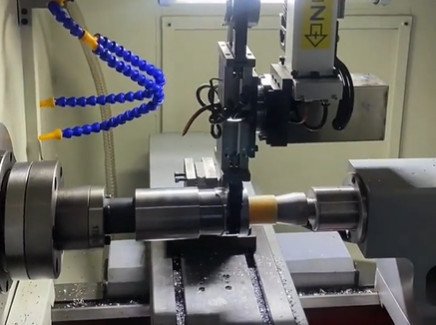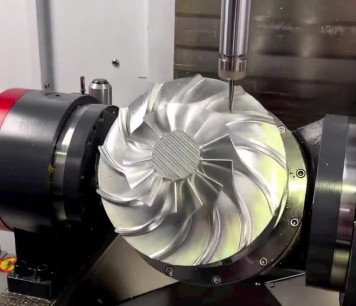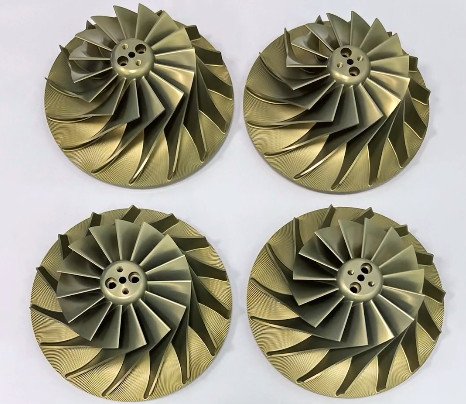Piston machining is a critical process in manufacturing high-performance components for internal combustion engines. This article provides a detailed, technical overview of piston machining, including processes, equipment, material considerations, and quality control measures. Designed for engineers and manufacturers, the content focuses on systematic approaches and specific parameters to achieve precision and reliability in piston production.
Overview of Piston Machining
Piston machining involves shaping raw materials into precise components that meet strict tolerances for engine performance. The process requires advanced equipment, skilled operators, and meticulous quality control to ensure durability, efficiency, and compatibility with engine systems. Key machining operations include turning, milling, grinding, and finishing, each tailored to specific piston features such as the crown, skirt, and ring grooves.
The primary goal is to produce pistons that withstand high temperatures, pressures, and mechanical stresses while maintaining tight tolerances. Machining must account for material properties, thermal expansion, and surface finish to ensure optimal performance in automotive, aerospace, or industrial applications.
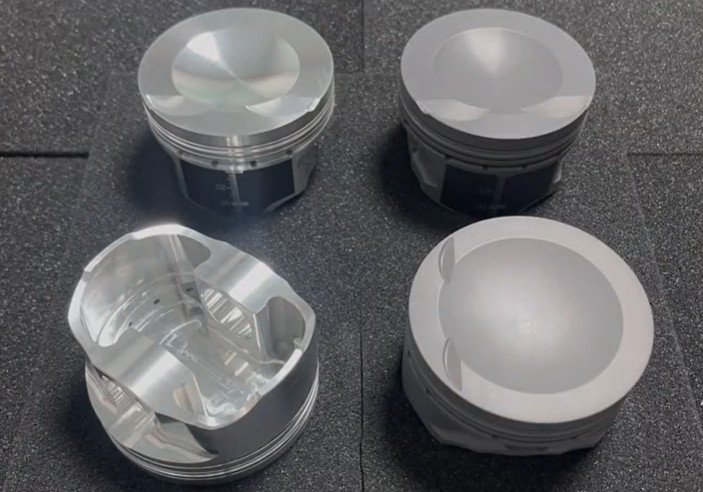
Materials Used in Piston Manufacturing
Pistons are typically made from aluminum alloys due to their lightweight, high strength, and excellent thermal conductivity. Common alloys include:
- Aluminum 4032: High silicon content (11-13%) for improved wear resistance and thermal stability.
- Aluminum 2618: Low silicon, higher strength for high-performance applications like racing engines.
- Cast Iron: Used in specific industrial applications for durability under heavy loads.
Material selection depends on the engine type, operating conditions, and cost considerations. Aluminum alloys are machined with high-speed tools, while cast iron requires slower cutting speeds to avoid excessive tool wear.
Machining Processes for Pistons
Piston machining involves multiple stages, each requiring precise control to achieve the desired geometry and surface finish. The main processes are outlined below.
Turning
Turning shapes the piston’s external surfaces, such as the skirt and crown. CNC lathes are commonly used for their precision and repeatability. Key parameters include:
| Parameter | Value |
|---|---|
| Cutting Speed | 150-300 m/min for aluminum alloys |
| Feed Rate | 0.1-0.3 mm/rev |
| Depth of Cut | 0.5-2 mm |
| Tool Material | Carbide or polycrystalline diamond (PCD) |
Turning ensures concentricity and prepares the piston for subsequent operations like milling and grinding.
Milling
Milling creates features such as ring grooves and pin bores. CNC milling machines with multi-axis capabilities are used to achieve complex geometries. Parameters include:
- Spindle Speed: 8,000-12,000 RPM for aluminum.
- Feed Rate: 0.05-0.15 mm/tooth.
- Coolant: High-pressure coolant to reduce heat and chip buildup.
Precision milling ensures tight tolerances for ring grooves, typically within ±0.01 mm, to ensure proper piston ring seating.
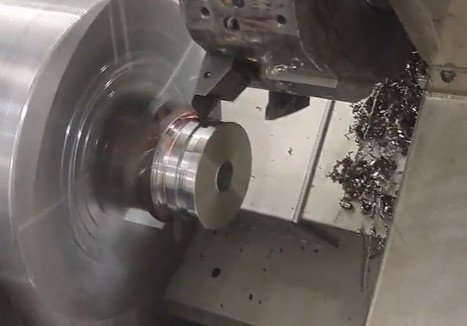
Grinding
Grinding refines the piston’s surface to achieve a smooth finish and precise dimensions. Cylindrical and surface grinders are used, with parameters such as:
- Wheel Speed: 30-50 m/s.
- Workpiece Speed:20-40 m/min.
- Grinding Wheel: Aluminum oxide or CBN (cubic boron nitride) for aluminum alloys.
Grinding achieves surface finishes as fine as Ra 0.2 µm, critical for reducing friction and wear in engine operation.
Finishing Operations
Finishing processes, such as honing and lapping, enhance surface quality and dimensional accuracy. Honing the piston skirt ensures proper clearance with the cylinder wall, typically 0.02-0.05 mm. Lapping may be used for high-performance pistons to achieve mirror-like finishes.
Equipment for Piston Machining
Modern piston machining relies on advanced CNC equipment to ensure precision and efficiency. Common machines include:
- CNC Lathes: For turning operations, offering high spindle speeds and automated tool changes.
- CNC Machining Centers: For milling complex features with multi-axis control.
- Grinding Machines: For high-precision surface finishing.
- Inspection Systems: Coordinate measuring machines (CMM) and laser scanners for quality control.
Equipment selection depends on production volume, piston complexity, and tolerance requirements. High-volume production may use dedicated transfer lines, while low-volume runs rely on flexible CNC setups.
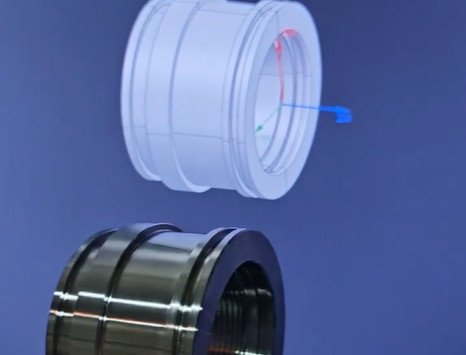
Quality Control in Piston Machining
Quality control ensures pistons meet design specifications and perform reliably. Key inspection methods include:
- Dimensional Inspection: Using CMM to verify tolerances, such as ±0.005 mm for critical features like pin bores.
- Surface Finish Testing: Profilometers to measure surface roughness (Ra 0.2-0.8 µm).
- Material Testing: Hardness testing (e.g., Rockwell or Vickers) to confirm material properties.
- Non-Destructive Testing: Ultrasonic or X-ray inspection to detect internal defects.
Statistical process control (SPC) monitors machining consistency, using control charts to track parameters like diameter and roundness.
Key Parameters for Piston Machining
Precision machining requires careful control of parameters to ensure consistency and quality. Below is a summary of critical parameters:
| Process | Parameter | Typical Value |
|---|---|---|
| Turning | Cutting Speed | 150-300 m/min |
| Milling | Spindle Speed | 8,000-12,000 RPM |
| Grinding | Surface Finish | Ra 0.2-0.8 µm |
| Honing | Clearance | 0.02-0.05 mm |
These parameters vary based on material, piston design, and application. For example, racing pistons require tighter tolerances and finer surface finishes than standard automotive pistons.
Common Issues in Piston Machining
While pain points are not the focus, certain technical challenges can arise during piston machining. These include:
- Tool Wear: High-speed machining of aluminum alloys can cause rapid tool wear, requiring frequent tool changes or advanced coatings like PCD.
- Thermal Distortion: Heat generated during machining can distort thin-walled piston skirts, necessitating precise coolant application.
- Chip Control: Aluminum’s ductility can lead to long, stringy chips that clog machines, requiring optimized chip-breaking techniques.
Addressing these issues involves selecting appropriate tools, optimizing cutting parameters, and using high-pressure coolant systems.
Best Practices for Piston Machining
To achieve high-quality pistons, manufacturers should follow these practices:
- Tool Selection: Use carbide or PCD tools for aluminum, and CBN for cast iron, to balance durability and precision.
- Process Optimization: Adjust feed rates and cutting speeds based on material and geometry to minimize defects.
- Quality Assurance: Implement in-process inspections using CMM and SPC to catch deviations early.
- Machine Maintenance: Regularly calibrate CNC machines to maintain accuracy and prevent downtime.
These practices ensure consistent production of pistons that meet performance and durability requirements.
Conclusion
Piston machining is a complex, precision-driven process that requires advanced equipment, careful material selection, and stringent quality control. By optimizing turning, milling, grinding, and finishing operations, manufacturers can produce pistons that meet the demands of modern engines. Key parameters, such as cutting speeds, feed rates, and surface finishes, must be carefully controlled to ensure reliability and performance. Through systematic processes and best practices, piston machining delivers components that power efficient, high-performance engines.
FAQs About Pistons
What is a piston?
A piston is a cylindrical component that slides back and forth inside a cylinder (typically in engines, pumps, or hydraulic systems). Its primary function is to convert energy: in engines, it transforms the pressure from expanding gases (combustion) into mechanical motion (rotating the crankshaft); in pumps or hydraulic systems, it moves fluids by creating pressure differentials.
What is the difference between a piston and a plunger?
Piston: Fits tightly inside a cylinder with minimal clearance, often using rings to seal against the cylinder wall. It is primarily used in engines to transfer force from pressure.
Plunger: Typically has a larger clearance with its cylinder and is used to move fluids in pumps (e.g., fuel pumps or hydraulic plunger pumps) without requiring a tight seal for combustion.
What are the key machining processes for pistons?
Turning: Shaping the outer diameter (OD) of the piston skirt and crown to precise dimensions using lathes.
Milling: Cutting features like piston ring grooves, valve pockets (in engine pistons), or cooling galleries (for high-performance designs).
Drilling/Boring: Creating oil holes, pin bores (for connecting rod attachment), or internal passages for lubrication or cooling.
Grinding: Finishing surfaces (e.g., the piston crown or skirt) to achieve smoothness and tight tolerances (often within ±0.001 mm).
Surface treatment: Applying coatings (e.g., anodizing, molybdenum disulfide) to reduce friction, enhance wear resistance, or improve heat dissipation.
